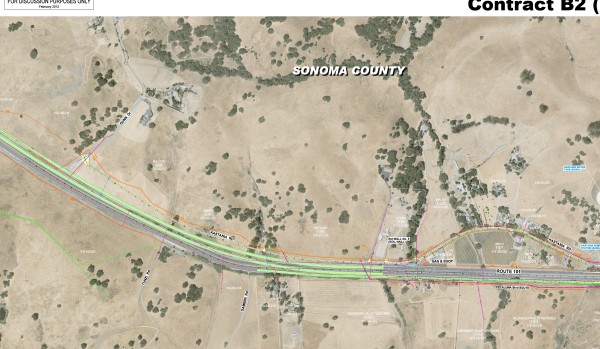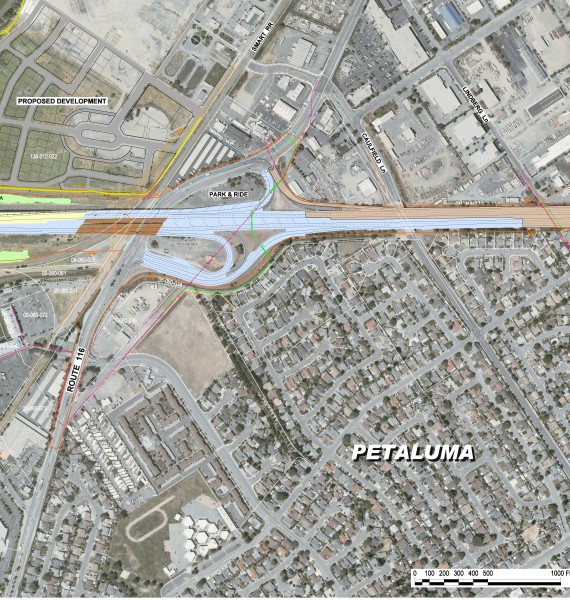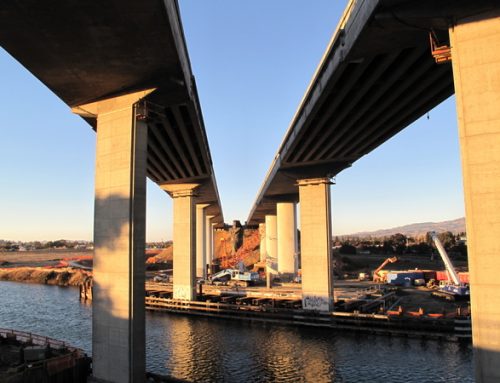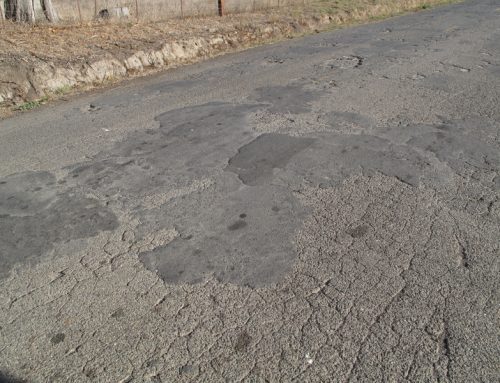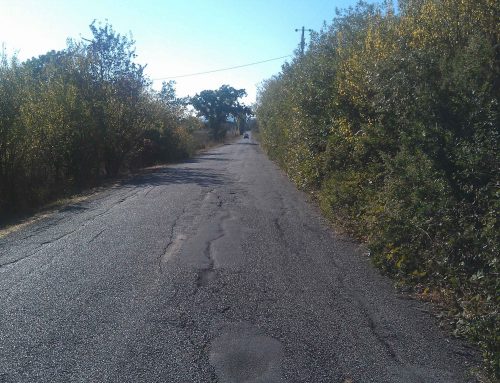Widening a 16-mile stretch of highway doesn’t sound like a big deal, but when that roadway is as complicated as the Novato Narrows, there is no quick fix. The $475 million Marin-Sonoma Narrows widening project began in April, 2013, and won’t be finished until 2016.
Representatives from Caltrans and the Sonoma County Transportation Authority recently took a drive through the project to answer questions and explain the construction that is causing agonizing delays between Petaluma Boulevard North (Old Redwood Highway) and Highway 37 in Novato. Here’s what they had to say.
Traffic has grown steadily over the years as a result of population growth and Sonoma County’s steadily growing tourism industry, which causes weekend gridlock. Bumper-to-bumper traffic heads north on Fridays and Saturdays, then returns south on Sundays.
The Narrows is the last four-lane stretch between Windsor and the Golden Gate Bridge, a remnant of days gone by with driveways and country roads that feed right into the highway. Portions are steep enough to slow big rigs and circuitous enough to block motorists’ views of traffic conditions ahead. The road also passes through two counties, which means any construction must be jointly planned and executed, and it contains four bridges that had to be widened or replaced.
When the project is done, it will have made room for HOV lanes, rebuilt bridges that cross 101 and created one central interchange between Petaluma and Novato, eliminating access from the small farm roads and San Antonio Road. And although Highway 101 will have been widened to accommodate six lanes, the middle two will remain closed until funding is available to create HOV lanes.
Officials say HOV work would take about two years and could begin as early as 2015 on the stretch of 101 between Petaluma Boulevard South and the Sonoma-Marin county line, as early as 2016 on the rest of the Narrows. Getting the money is likely to take longer. Expect bottlenecks to continue until at least 2020, Press Democrat reporter Matt Brown wrote in a recent story.
“This whole project is setting (Highway 101) up for future HOV lanes,” Jit Pandher of the Transportation Authority of Marin said in an earlier conversation. That includes acquiring right-of-ways, doing environmental impact studies, relocating utilities and reconfiguring the highway for six lanes of traffic.
When funding for the HOV lanes is available, it will be easy to add them, providing the final link between Windsor and the Golden Gate Bridge.
Click here to read an earlier report about the southern portion of the project overseen by the Transportation Authority of Marin, including the Redwood Landfill interchange, and some answers to earlier questions (read them here).
The lion’s share of Sonoma County’s early attention has gone to bridge-building. The most complicated of the projects is replacing the four-lane Petaluma River Bridge with a new structure wide enough to hold six lanes of traffic and long enough to make more room for larger boats to pass beneath.
They also are building a new interchange at Kastania Road, requiring a new four-lane bridge across 101. And existing two-lane bridges at Old Redwood Highway/North Petaluma Boulevard and the Redwood Landfill are being expanded to four lanes, requiring the construction of new two-lane bridges alongside.
The next phase will involve regrading the hill and adjusting the curve at San Antonio Road.
Only when these tasks have been completed can the highway be widened and repaved. Starting first with the largest projects under construction:
* Petaluma Boulevard South Interchange / Petaluma River Bridge ($127 million) — In addition to replacing the bridge, the existing Petaluma Boulevard South interchange will be replaced by a new tight diamond interchange at Kastania Road. The existing Boulevard will continue south on both sides of the highway, serving local traffic as frontage roads with Class II bike lanes. Once all the phases of the widening project are complete, the bike lanes will connect to those running north from Novato. (See map below.)
By doing this work to restrict vehicles from entering 101 except at formal interchanges, the highway will qualify as an expressway, setting the stage for future HOV lanes. Work began in January 2013 and should be done by 2016
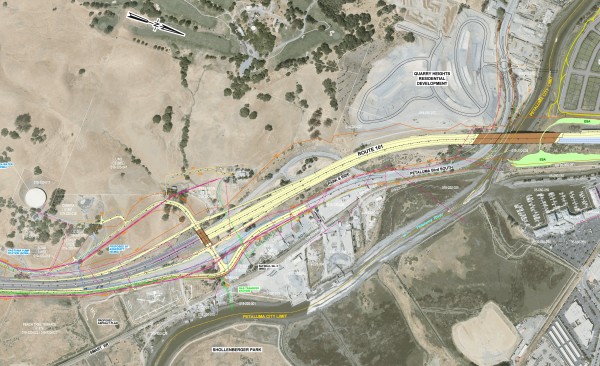
Middle section of the Marin Sonoma Narrows project showing the new Petaluma Boulevard South interchange. Click to enlarge. (Caltrans illustration)
* Kastania Road interchange (included in the Petaluma Boulevard budget) — The new bridge crosses 101 just south of the existing South Petaluma Boulevard interchange. Westbound traffic will connect with the existing Kastania Road, which will serve as a frontage road serving farms and the gas station. That road will end at Gunn Road. (See map below.) Work is underway and is expected to finish in 2015.
Just south of Gunn Road, the freeway will be shifted slightly to the west to provide a better line of sight for northbound drivers. The southbound lane will move to the west, and the northbound lane will move into the existing southbound lane. The new lanes are visible as green lines on the map below.
* San Antonio curve correction (not yet under contract) — Highway 101’s alignment as it crosses San Antonio Hill haven’t changed since the road was designed in 1953 or 1954, although speeds have changed dramatically. To make it safer, the road will be moved to the west and the grade will be flattened between San Antonio Road and the Petaluma River Bridge. A new six-lane bridge also will be built over San Antonio Creek to resolve flooding issues, and a new Class I bike lane will be built along the creek, connecting east and west frontage roads.
Access to the freeway from San Antonio Road also will be restricted, with local traffic directed south along the frontage roads to an expanded interchange at the Redwood Landfill. Work is expected to begin in 2015 and end in 2017.
* Redwood Landfill interchange — Marin County has been in charge of expanding the existing two-lane bridge to four lanes and creating a true tight-diamond interchange with on- and off-ramps in each direction. It is expected to be done in 2014.
Other smaller projects further north include:
* Old Redwood Highway/North Petaluma Boulevard ($27 million) — The two-lane overcrossing will be widened to four lanes, and new on- and off-ramps will be built. The new structure that will hold the two new lanes is being built alongside the existing bridge. Sound walls also are being built there. It is expected to be done in 2015.
* Lakeville Highway (Route 116) Interchange ($32.9 million) — The existing Lakeville Highway bridges will be widened to make room for the future HOV lane, and truck climbing lanes on Highway 101 will be upgraded in both directions. Sound walls also will be installed. All traffic is scheduled to shift onto the southbound bridge in mid-December so the northbound bridge can be demolished. All work is expected to wrap up in 2015.
Stay tuned this week for answers to more specific questions from Road Warrior readers.


